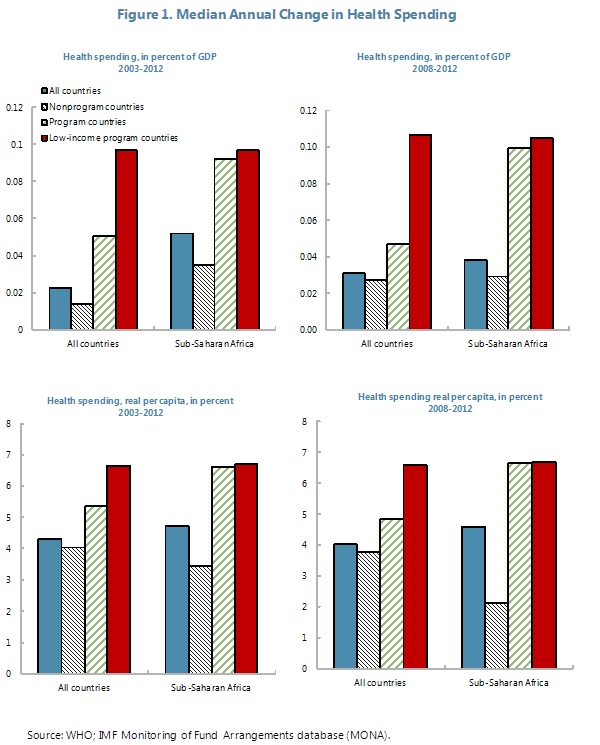One way to improve healthcare
Stay up to date:
Future of Global Health and Healthcare
Improvements in health can have a tremendously positive effect on society’s well-being and the level of economic activity. Indeed, 2013’s path-breaking report by the Lancet Commission indicates that about 11 percent of the economic growth in recent decades can be attributed to these improvements. As such, it makes good sense for macroeconomists to pay attention to health indicators and to the factors that influence them, such as public health spending.
In this context, it is not surprising that the impact of IMF-supported programs on public health spending has generated considerable attention. Previous research, focusing on periods before the global financial crisis, indicates that Fund-supported programs have a positive effect on public health spending (Martin and Segura, 2004; Center for Global Development, 2007; Clements, Gupta and Nozaki, 2013). But does this pattern still hold if we extend the analysis to more recent years? In this blog, we take a fresh look at this evidence for developing economies.
Based on our assessment of developments over 2003 to 2012, we find that the broad patterns identified in our earlier peer reviewed empirical analysis still hold, with spending rising at a brisker pace in countries with Fund-supported programs than those without (Figure 1). For example, we find that health spending has been rising, as a share of GDP, at a faster annual pace in countries with Fund-supported programs. This is especially the case for low-income countries (which pay zero interest under Fund-supported programs), as well as those of Sub-Saharan Africa. Over a 10 year period, the cumulative difference between program and non-program low-income countries is substantial—about 0.6 percentage points of GDP. Our 2013 econometric analysis indicates that if we control for macroeconomic factors that affect health spending, the impact almost doubles.
We get the same picture of the effect of Fund-supported programs if we focus on other measures of spending increases. For example, real health spending per person grew by an average of about 6½ percent a year in low-income countries with programs; those without programs, in contrast, averaged spending increases of 4½ percent. When we look at developments between the beginning of the global financial crisis in 2008 and 2012, we have a similar story. Countries adversely affected by the Ebola virus also show greater spending increases (as a percent of GDP) during periods with Fund-supported programs, with Guinea increasing by 0.7 percentage points, Liberia by 1.6, and Sierra Leone by 0.24 points (from 2010 to 2013).
Why do Fund-supported programs have a positive effect on health spending? As suggested in our earlier work, one reason is the emphasis in these programs on tax reforms that raise revenues, which can help countries increase social spending in a fiscally sustainable manner. Furthermore, to the extent that programs lead to higher economic growth, IMF-supported programs can help generate the fiscal space (including through more robust revenue growth) to finance these outlays. Another channel is the catalytic effect of IMF-supported programs on donor financing, which can also deepen the pool of resources to finance priority spending on both health and other programs. More recently, the incorporation of minimum floors on social spending in Fund-supported programs has also encouraged countries to raise health spending. The IMF’s Independent Evaluation Office found that 29 of 30 recent programs incorporated these minimum floors (IEO, 2014).
In sum, recent evidence continues to suggest that Fund-supported programs are compatible with country plans to expand public spending on health. Raising health spending, of course, is just one piece of the puzzle for achieving better health outcomes. In particular, countries should also focus on reforms that improve the efficiency of this spending, where there is significant room for improvement (Coady, Francese, and Shang, 2014).

This article is published in collaboration with IMF Direct. Publication does not imply endorsement of views by the World Economic Forum.
To keep up with Forum:Agenda subscribe to our weekly newsletter.
Author: Benedict Clements is Division Chief for the Expenditure Policy Division of the IMF’s Fiscal Affairs Department. Sanjeev Gupta is Acting Director in the Fiscal Affairs Department of the International Monetary Fund (IMF). Masahiro Nozaki is a media-lead Contents Director.
Image: A nurse poses for a photo in a trauma center of the University of Mississippi Medical Center in Jackson, Mississippi October 4, 2013. REUTERS/Jonathan Bachman.
Don't miss any update on this topic
Create a free account and access your personalized content collection with our latest publications and analyses.
License and Republishing
World Economic Forum articles may be republished in accordance with the Creative Commons Attribution-NonCommercial-NoDerivatives 4.0 International Public License, and in accordance with our Terms of Use.
The views expressed in this article are those of the author alone and not the World Economic Forum.
Forum Stories newsletter
Bringing you weekly curated insights and analysis on the global issues that matter.
More on Economic GrowthSee all
Samir Saran and Anirban Sarma
April 17, 2025
Lucia Fry and Naomi Nyamweya
April 17, 2025
Nada AlSaeed
April 16, 2025
Aengus Collins
April 15, 2025
Spencer Feingold
April 15, 2025





